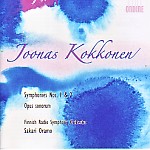As with its superb predecessor, this disc offers outstanding performances, just a smidge finer overall than the otherwise excellent competition on BIS, a fact that stems mostly from the richer, weightier timbre of the string section on display here. However, I can’t quite go for the highest rating because the music itself, while very serious and well-crafted, isn’t quite as enjoyable as the works from Kokkonen’s later, tonal period featured on the earlier release. In their day, the First and Second Symphonies were hailed as reconciling the sound-world and organic structural technique of Sibelius with the 12-tone method, and so they do. For example, the third movement of the First Symphony contains an obvious reference to the storm music in Tapiola, here becoming a natural outgrowth of Kokkonen’s symphonic thought. It’s really deftly done, and expressively convincing.
In Finland in the 1960s, this was understandably a Big Deal, and it vaulted Kokkonen to the forefront of modern Finnish composers. But from our vantage point today, it could be argued that these works, for all their seriousness of purpose, sound overly austere and emotionally restrained. Still, they are instantly identifiable as Kokkonen and no one else: the gaunt atmosphere, typified by somber string cantilenas splotched with pure woodwind colors, as well as the lean, clear use of counterpoint, feature prominently in all of his music from whatever period. The music also is far from unapproachable, despite the somewhat gnarly basic idiom, and the same holds true of Opus Sonorum (1964), which reveals the composer on his way to his “breakthrough” work–the marvellous Third Symphony. So if you don’t mind a challenge and enjoy Kokkonen’s later output, you will want this excellently engineered release too. In the final analysis, his music really is all of a piece.
































